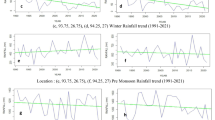Abstract
The continuous extraction of wood and the conversion of forest to small- and large-scale agricultural parcels is rapidly changing the land cover of the mount Cameroon region. The changes occur at varying spatial scales most often not more than 2ha for the small-scale subsistence farms and above 10ha for the extensive agricultural plantations of cocoa and palm. Given the importance of land use and land cover data in conservation planning, accurate and efficient techniques to provide up-to-date change information are required. A number of techniques for realising the detection of land cover dynamics using remotely sensed imagery have been formulated, tested and assessed with the results varying with respect to the change scenario under investigation, the information required and the imagery applied. In this study the Change Vector Analysis (CVA) technique was implemented on multitemporal multispectral Landsat data from the Thematic Mapper (TM) and Enhanced Thematic Mapper (ETM) sensors to monitor the dynamics of forest change in the mount Cameroon region. CVA was applied to multi-temporal data to compare the differences in the time-trajectory of the tasseled cap greenness and brightness for two successive time periods – 1987 and 2002. The tasseled cap was selected as biophysical indicator because it optimises the data viewing capabilities of vegetation, representing the basic types of land cover – vegetation, soil and water. Classes were created arbitrarily to predict the technique‘s potential in monitoring forest cover changes in the mount Cameroon region. The efficiency of the technique could not be fully assessed due to the inavailability of sufficient ground truth data. Assessment was based on the establishment of an error matrix of change versus no-change. The overall accuracy was 70%. The technique nevertheless demonstrated immense potentials in monitoring forest cover change dynamics especially when complemented with field studies.
Similar content being viewed by others
References
Cohen, W. B., Fiorella, M., Gray, J., Helmer, E., & Anderson, K. (1998). An efficient and accurate method for mapping forest clear-cuts in the Pacific Northwest Using Landsat imagery. Photogrammetry Engineering and Remote Sensing, 64(4), 293–300.
Coppin, P., & Bauer, M. (1996). Digital Change Detection in Forest Ecosystems with Remote Sensing Imagery. Remote Sensing Review, 13, 207–234.
Coppin, P., Jonckheere, I., Nackaerts, K., Muys, B., & Lambin, E. (2004). Digital Change Detection methods in Ecosystem Monitoring: a Review. International Journal of Remote Sensing, 25(9), 1565–1596.
Deer, P. J. (1995). Digital change detection techniques: Civilian and military applications. http://ltpwww.gsfc.nasa.gov/ISSSR-95/digitalc.htm.
Essama Nssah, B., & Gockowski J. J. (2000). Cameroon. forest sector development in a difficult political economy. evaluation country case study series. The World Bank Operations Evaluation Department.
Jensen, J. (1996). Introductory digital image processing. A remote sensing perspective. 2nd Edition. New Jersey: Prentice Hall.
Johnson, R. D., & Kasischke, E. S. (1998). Change vector analysis: A technique for the multispectral monitoring of land cover and condition. International Journal of Remote Sensing, 19(3), 411–426.
Kuzera, K., Rogan, J., Eastman, J. R. (2005). Monitoring vegetation regeneration and deforestation using change vector analysis. St. Helens Study Area.
Lambin, E. A., & Strahler, A. H. (1994). Indicators of land cover change for change vector analysis in multitemporal space at coarse spatial scales. International Journal. of Remote Sensing, 15, 2099–2119.
Lillesand, T., & Kiefer, R. (2000). Remote sensing and image interpretation. Fourth edition. New York: Wiley.
McCormick, N. (1999). Satellite-based forest mapping using the SILVICS software. User Manual.
Singh, A. (1989). Digital change detection techniques using remotely-sensed data. International Journal of Remote Sensing, 10(6), 989–1003.
Sohl, T. L. (1999). Change vector analysis in the United Arab Emirates: An investigation of techniques. Photogrammetry Engineering and Remote Sensing, 65(4), 475–484.
Van dorp, M. (1995). Shaking the tree: An economic geographical analysis of the foreign impact on forestry in Cameroon. Tropenbos – Cameroon Programme, Kribi, Cameroon.
Author information
Authors and Affiliations
Corresponding author
Rights and permissions
About this article
Cite this article
Siwe, R.N., Koch, B. Change vector analysis to categorise land cover change processes using the tasselled cap as biophysical indicator. Environ Monit Assess 145, 227–235 (2008). https://doi.org/10.1007/s10661-007-0031-6
Received:
Accepted:
Published:
Issue Date:
DOI: https://doi.org/10.1007/s10661-007-0031-6




